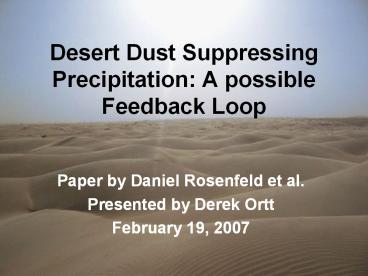Desert Dust Suppressing Precipitation: A possible Feedback Loop - PowerPoint PPT Presentation
1 / 18
Title:
Desert Dust Suppressing Precipitation: A possible Feedback Loop
Description:
Short dash = 85 percentile. Black and red lines correspond to dusty boxes ... Black: Concentrations from sky radiometers (Sde-Boker: solid, Cape Verde: dashed) ... – PowerPoint PPT presentation
Number of Views:64
Avg rating:3.0/5.0
Title: Desert Dust Suppressing Precipitation: A possible Feedback Loop
1
Desert Dust Suppressing Precipitation A possible
Feedback Loop
- Paper by Daniel Rosenfeld et al.
- Presented by Derek Ortt
- February 19, 2007
2
Background
- Twomey et al. (1987) and Rosenfeld (2000) found
that areosols from smoke and anthropogenic
pollution cause high concentrations of small CCN - Small CCN results in formation of fewer
precipitation droplets - Levin et al. (1996, 2000) found that desert dust
leads to the formation of giant CCN, and enhances
precipitation - Giant CCN enhance collision and coalescence,
allowing for the formation of more raindrops - Is the Levin et al. hypothesis correct?
3
If it were, I would not be giving this talk!!!
- Dust storm over Mid-East on March 16, 1998
- Red areas of dust
- Satellite, aircraft, and laboratory observations
suggest that droplets formed with dust as CCN are
lt14 micrometers, which favors clouds, but little
precip (Rosenfeld, 1994)
4
For all plots effective radius on x-axis,
temperature on y axis Long dash 15
percentile Solid 50 percentile Short dash 85
percentile Black and red lines correspond to
dusty boxes Vertical green line is 14 micrometer
precip threshold
5
March 1, 2000
DUST
DUST
March 6, 2000
Areas covered by TRMM overpass
6
Aerosol Map
Blue smoke Orange sulfates Green Desert Dust
March 1, 2000
March 6, 2000
7
PR pass from March 1
4
3
clear
1
2
dusty
Only precip
8
Lines 1-4 correspond to boxes 1-4 on previous
slide
Line 5 from heavy dust storm
9
1 Dust laden clouds, 2 Dust free clouds, 3
Smoke
10
Particle Size Distributions
CCN concentrations assume all vertically
integrated particles lie within a 1km2 column
Black Concentrations from sky radiometers
(Sde-Boker solid, Cape Verde dashed) Blue
Conversion of dust into CCN Red CCN concentration
11
How dust acts as CCN
- 65 of particles contained sulfur from ground
- Sulfur accumulates on dust particle via following
relation log(S) 2.13 log(d) 13.44
(ddiameter) - Calculate the equivalent NaCl CCN using drop size
distribution and sulfur mass - Transformation shown on previous slide shifts the
dust particle distribution to smaller sizes of CCN
12
Climatic Effects
13
Levy et al. (2007)
Dust
14
Dust effects on Climate
- Leads to cloud formation with little
precipitation - Increases atmospheric albedo, cooling the earth
- Increases greenhouse effect warming middle
troposphere - New temperature profile creates a more stable
atmosphere, further suppressing precip - Continous feedback cycle could lead to
15
(No Transcript)
16
Solid line frequency of dust occurrence at Gao
from 1957-1980 (left axis, Bars Rainfall
anamolies for Sahel as a whole Dust is
represented as number of days with dust haze
17
Monthly Mean Rainfall
Hours of reduced visibility on left axis (lt5km
solid, 5ltvislt10 open) mm of rainfall on right axis
18
Conclusions
- Desert dust is a source of CCN
- Droplets typically do not grow to precipitation
size when dust is CCN - Dust creates a more stable atmosphere
- Feedback develops and could lead to a further
expansion of the desert areas































